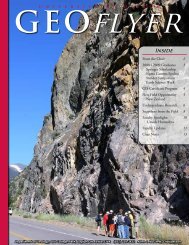Stander Symposium abstract book - University of Dayton
Stander Symposium abstract book - University of Dayton
Stander Symposium abstract book - University of Dayton
Create successful ePaper yourself
Turn your PDF publications into a flip-book with our unique Google optimized e-Paper software.
9:00 AM to 10:30 AM<br />
Isolation and Characterization <strong>of</strong> Wastewater Phage<br />
Presenter(s): Yexun Wang<br />
Advisor(s): Denise G Taylor<br />
Civil-Environmental Engineering and Engineering Mechanics - Graduate Research<br />
Biological transformation processes are widely used in wastewater treatment, where those processes are dependent on mixed microorganisms,<br />
mainly bacteria. However, filamentous bacteria, a type <strong>of</strong> existing bacterial microorganisms in wastewater, need to be controlled to prevent excessive<br />
overgrowth that interferes with wastewater treatment. Current research on this program is seeking a biocontrol <strong>of</strong> filamentous bacteria via<br />
selective bacteriophages other than chemicals to protect other useful microbes. This project is to search for a number <strong>of</strong> phage groups that control<br />
the growth <strong>of</strong> specific filamentous bacteria in sludge production processes without interfering with the other bacteria. Samples were enriched for<br />
phage. Phages were isolated in one <strong>of</strong> two host bacteria and then selectivity tested against the other host. Sphaerotilus natans, a type <strong>of</strong> filamentous<br />
bacteria that is known in the activated sludge process, was used as the host with inoculating phages, as well as E.coli which may be common<br />
in wastewater treatment processes. Samples were obtained <strong>of</strong> supernatant from diverse treatment processes at various wastewater treatment<br />
plants. All the samples were thought to be good candidates since no article pointed out which process was better than the others. Other than<br />
the optimum control conditions regarding enrichment, maintenance and storage that is still being explored, the controls <strong>of</strong> growth, inoculation<br />
methods and storage <strong>of</strong> hosts would be recommended individually and compared with previous protocols.<br />
Accelerating Robotic Arm Calibration on GPGPUs<br />
Presenter(s): Chong Chen<br />
Advisor(s): Tarek M Taha<br />
Electrical and Computer Engineering - Graduate Research<br />
We examine the acceleration <strong>of</strong> a robotic arm calibration algorithm using a general purpose GPU (GPGPU). The algorithm utilized requires a radial<br />
basis function neural network for calibration and takes approximately 9 days to run on a standard desktop computer. The most time consuming<br />
component <strong>of</strong> this algorithm is a matrix inversion operation. This is carried out on an NVIDIA GPGPU using the Cholesky Factorization. On an NVIDIA<br />
Tesla S1070 GPGPU, this same algorithm ran about 300 times faster than a standard desktop computer running an optimized version <strong>of</strong> the code.<br />
Analysis <strong>of</strong> Motion Blur Using Double Discrete Wavelet Transform<br />
Presenter(s): Yi Zhang<br />
Advisor(s): Keigo Hirakawa<br />
Electrical and Computer Engineering - Graduate Research<br />
Object motion causes spatially varying blur. Estimating such a type <strong>of</strong> blur from a single image is an ill-posed problem that is difficult to solve. In<br />
this paper, we introduce the notion <strong>of</strong> double discrete wavelet transform (DDWT) designed to sparsify the blurred image and blur kernel simultaneously.<br />
Based on DDWT analysis, we are able to accurately estimate motion blur kernels and recover the latent sharp image. The blind image<br />
deblurring solution proposed here handles spatially varying motion blurs effectively and efficiently.<br />
Barium Strontium Titanate Varactor-Tuned Spiral Bandstop Filter for Microwave<br />
Applications<br />
Presenter(s): Hailing Yue<br />
Advisor(s): Guru Subramanyam<br />
Electrical and Computer Engineering - Graduate Research<br />
A novel Barium-Strontium-Titanate(BST) varactor-tuned spiral bandstop filter (BSF) is presented. The BST varactor operation is based on the<br />
nonlinear dielectric tunability <strong>of</strong> BST thin film sandwiched between two metal layers in a conductor-backed coplanar waveguide(CBCPW) transmission<br />
line configuration. The varactor area is formed by the overlap area between the spiral shunt line in the bottom metal layer and the center<br />
signal line in the top metal layer. The considered spiral-structured devices <strong>of</strong> spiral shunt line sizes were designed, simulated and fabricated. The<br />
fabricated BSF is expected to achieve up to 40 dB rejection at microwave stop band with an optimized Q factor.<br />
66

















